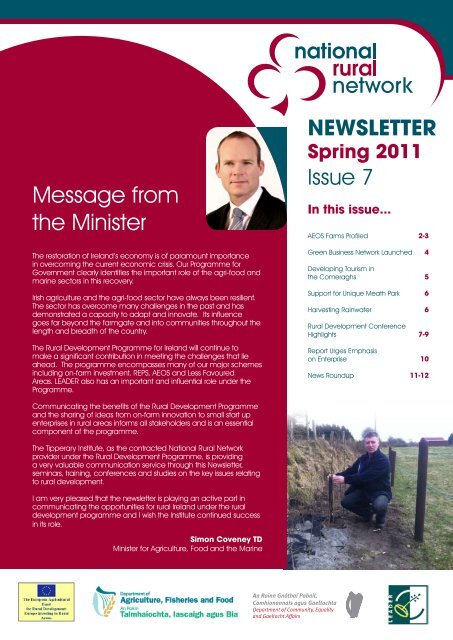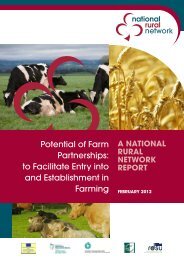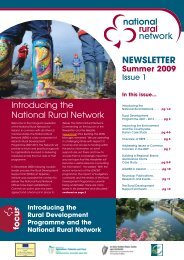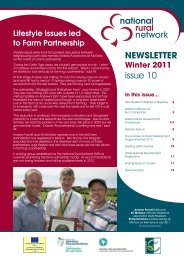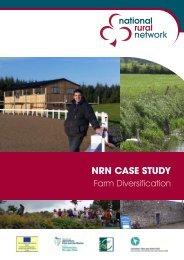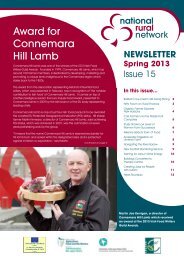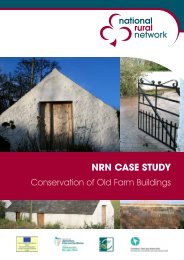Tipperary Green Business Network Launched - National Rural ...
Tipperary Green Business Network Launched - National Rural ...
Tipperary Green Business Network Launched - National Rural ...
- No tags were found...
You also want an ePaper? Increase the reach of your titles
YUMPU automatically turns print PDFs into web optimized ePapers that Google loves.
RN NNATIONALRURAL NETWORKNATIONALRURAL NETWORKRN NNATIONALRURAL NETWORKMessage fromthe MinisterThe restoration of Ireland’s economy is of paramount importancein overcoming the current economic crisis. Our Programme forGovernment clearly identifies the important role of the agri-food andmarine sectors in this recovery.Irish agriculture and the agri-food sector have always been resilient.The sector has overcome many challenges in the past and hasdemonstrated a capacity to adapt and innovate. Its influencegoes far beyond the farmgate and into communities throughout thelength and breadth of the country.The <strong>Rural</strong> Development Programme for Ireland will continue tomake a significant contribution in meeting the challenges that lieahead. The programme encompasses many of our major schemesincluding on-farm investment, REPS, AEOS and Less FavouredAreas. LEADER also has an important and influential role under theProgramme.NewsletterSpring 2011Issue 7In this issue...AEOS Farms Profiled 2-3<strong>Green</strong> <strong>Business</strong> <strong>Network</strong> <strong>Launched</strong> 4Developing Tourism inthe Comeraghs 5Support for Unique Meath Park 6Harvesting Rainwater 6<strong>Rural</strong> Development ConferenceHighlights 7-9Report Urges Emphasison Enterprise 10News Roundup 11-12Communicating the benefits of the <strong>Rural</strong> Development Programmeand the sharing of ideas from on-farm innovation to small start upenterprises in rural areas informs all stakeholders and is an essentialcomponent of the programme.The <strong>Tipperary</strong> Institute, as the contracted <strong>National</strong> <strong>Rural</strong> <strong>Network</strong>provider under the <strong>Rural</strong> Development Programme, is providinga very valuable communication service through this Newsletter,seminars, training, conferences and studies on the key issues relatingto rural development.I am very pleased that the newsletter is playing an active part incommunicating the opportunities for rural Ireland under the ruraldevelopment programme and I wish the Institute continued successin its role.Simon Coveney TDMinister for Agriculture, Food and the MarineAn Roinn Gnóthaí Pobail,Comhionannais agus GaeltachtaDepartment of Community, Equalityand Gaeltacht Affairs
N NNATIONALRURAL NETWORKProfiles of AEOS FarmsSome 9,000 participants in the Agri-Environment Options Scheme (AEOS) have been busy in recentmonths complying with various environmental options under the scheme.The objectives of the AEOS are:• To promote biodiversity, encourage water management/quality and combat climate change• To contribute to positive environmental, management of farmed Natura 2000 sites and river catchments inthe implementation of the Birds Directive, Habitats Directive and Water Framework Directive.We profile three farmers who have joined the scheme and outline the actions they areimplementing.Maintaining Stone Walls in Roscommonscheme - two priority actions andthree complementary actions.He is growing one hectare oftraditional hay meadow andhas opted to maintain a riparianmargin of around 100 metresbeside a stream that runs alongthe boundary of the farm. Thisinvolves putting a fence at least2.5 metres from the stream andinstalling a trough as a drinkingsource for cattle.N NRN NHe committed to plant 475metres of hedgerows along theinner side of boundary ditcheswith neighbouring farms and oninternal ditches. This has now beencompleted and all necessaryfencing is done. The hedgerows,which Michael planted himself,consist mainly of whitethorn.He is currently planting about 15trees – a mixture of oak, ash andsycamore – along a section of thefarm boundary and has committedRNATIONALRURAL NETWORKNATIONALRURAL NETWORKNATIONALRURAL NETWORKto establish a traditional orchard with15 native apple varieties. As thesupply of native varieties has run out,he will have to wait until next year toimplement this part of his plan.Breian Carroll ran a demonstrationon the implementation of keyaspects of the AEOS on MichaelDevaney’s farm in early March.Over 50 farmers from the Swinfordlocality attended the event.Liam Gately farms at Dysartin south Roscommon, an arearenowned for its traditional stonewalls. The 30 ha of owned land (afurther 15 ha is rented) consists ofa maze of stone walls in externaland internal boundaries. It istherefore not surprising that LiamMichael Picks Five ActionsLiam Gately, maintaining 6.5km of traditional stone wallsopted for maintenance of thesetraditional stone walls as one ofthe actions under his AEOS plan.He has undertaken to maintain atotal of 6,491 metres of these wallsas a complementary action.He has selected 2.8 ha oftraditional hay meadow as theMichael Devaney, planting475 metres of hedgespriority environmental action underthe scheme. In order to qualify,the sward must have at leastthree grass species, other thanryegrass, and must be grazedin accordance with traditionalpractices.The meadow must not receivemore than 30 kg of nitrogen/haand cannot be cut until after 1 July.If, due to bad weather or otherreasons, hay cannot be saved, thegrass can be turned into silage butit must be turned at least twice inorder for the seeds to disperse.Liam Gately runs 20 suckler cows,with the male progeny reared tobeef, and a 140-ewe mid-seasonlambing flock. His AEOS plan wasdrawn up under the guidance ofTeagasc adviser, James Kelly.Michael Devaney, who farmsat Drumshinnagh, Swinford,Co Mayo, was one of the earlyparticipants in REPS. He joined thescheme in 1995 and completedREPS 3 in 2009. He was delightedwith the opportunity the AEOSafforded him to further improve thevisual image and environmentalstandards of his 9ha suckling farm.Under the guidance of agriculturalconsultant, Breian Carroll, Michaelselected five actions under the‘Always more to be done’Kim McCall, who farmsat Calverstown, Co Kildare,has a strong track record inenvironmental friendly farming.He is a former national winnerof two farming conservationawards, sponsored by Teagasc,the RDS and the Farmers Journal.One of the country’s earliestREPS participants, he was also aregional winner of the nationalREPS awards.Convinced there is always morethat can be done to enhancethe farm environment, he wasan enthusiastic applicant forthe AEOS. With Carlow-basedagricultural consultant, PatMinnock, he selected fourKim McCall in the traditionalorchard he has plantedactions under the scheme.He runs a herd of pedigreeAubrac sucklers and a flockof rouge-cross ewes on theall-grassland farm of 8.3 ha.One of the priority actions heselected under the AEOS is themaintenance of just over 10 haof species-rich dry grassland.The grassland must contain atleast five ‘positive’ indicatorspecies. Over 20 such speciesare specified in the terms andconditions of the scheme. Also,the grassland must not containmore than 20% in total of‘negative’ indicator species, ofwhich 12 are listed in the termsand conditions.No artificial fertiliser, slurry,farmyard manure or otherorganic material can be appliedto the grassland. Topping isprohibited until after 15 July andthe stocking density and grazingregime must be such as toconserve the ecological integrityof the habitat. There is also ageneral prohibition on the use ofherbicides.Kim has also undertaken to growaround 3.5 ha of traditionalhay meadow. Another actionhe has just completed is therevitalisation and fencing of anold hedge which had gone intoa severe state of disrepair. Itconsisted of a mixture of mainlywhitethorn and elm. He trimmedit up and planted a mixture ofwhitethorn, field maple, dogrose and buckthorn. The plancommitted him to revitalise 100metres but he did a total of 180metres.Kim’s final action was theplanting of a traditional orchardwith a minimum of 10 nativeapple trees. For good measure,he planted a further nine otherapple trees.p2p3
N NNATIONALRURAL NETWORK<strong>Tipperary</strong> <strong>Green</strong> <strong>Business</strong> <strong>Network</strong> <strong>Launched</strong>A new <strong>Green</strong> <strong>Business</strong> <strong>Network</strong> hasbeen launched in <strong>Tipperary</strong> withthe aim of bringing together allagencies and information sourceson the full array of green issues.The network, which was launched ata function at the <strong>Tipperary</strong> Instituteon 6 April, emanated from a highlysuccessful green economy eventheld in January, which attractedan attendance of 150 from Northand South <strong>Tipperary</strong> and adjoiningcounties.Organised by North <strong>Tipperary</strong>Leader Partnership (NTLP), inassociation with the <strong>Tipperary</strong>Institute and Cultivate.ie, the eventon ‘Finding Opportunity in the <strong>Green</strong>Economy’ featured presentations,demonstrations and discussionon business, training and fundingopportunities in the areas of greenenergy, construction, tourism,One of the presentations at thegreen economy event at the<strong>Tipperary</strong> Institute was by therecently established company, TippWood Chip. Run by father and sonteam, Seamus and Brian Maher atTwo-Mile-Borris, the company wasestablished in September 2009.It is now supplying over 1,000 tonnesof wood chip a year and ordersare continuing to grow. Customersinclude Rockwell College, theAnner and Hayes Hotels in Thurles, acommunity centre, two mushroomfarms and a number of privatehouses.The company got a grant of€15,000 and a loan of a further€15,000 from the <strong>Tipperary</strong>Enterprise Board. Brian Maher saidthey are on target to break even thisyear and will hopefully start turning aprofit in 2012.Up to now, they purchased thinningsagriculture and food.Gearóid Fitzgibbon, regionalcommunity worker with NTLP andone of the organisers of the event,said a key conclusion of the eventwas that ‘green’ is no longer specificto environmentalists or activists.“<strong>Green</strong> is as much about savingsand efficiency. In a world of scarceresources, there are enormousbusiness opportunities opening upin transforming the old wasteful wayof doing things, moving the natureof business into the business ofnature.The main outcome from the eventwas the decision to set up the<strong>Tipperary</strong> <strong>Green</strong> <strong>Business</strong> <strong>Network</strong>.The launch of the network on 6April was accompanied by aworkshop on ‘<strong>Tipperary</strong> as an EcoCounty’. The network will organiseregular meetings, with expertWood Chip Company Expandsfrom Coillte and private forests. Thewood is stored in an exposed areato ensure maximum drying so thatthe chip can be sold at 20-25%moisture. Brian Maher said they arenow moving away from thinningsand aim to get as much rawmaterial as possible in the form ofboxwood and sawmill log. “It driesquicker and there is less bark,” hesaid.Chipping is done on contractby Cork company, Ballynoe Agri-Services, which calls to the premisesspeakers, mentoring and interactiveworkshops and training sessions.The first meeting is planned forlate April. Gearóid Fitzgibbonsaid the ideas that have alreadyarisen include the setting up of awebsite where all organisationscan post their eco projects andsupport agencies can link into.The development of a directory ofskilled students who would be willingto get involved in aspects such asresearch and web design is anothersuggestion that is being pursued.The network is also looking atdeveloping linkages with otherprojects around the country, suchas the Ballynagran zero carbonproject in Wicklow. Using theFairtrade model to achieve ECOstatus is also being examined.Wood for chipping is stored in anexposed area to ensure maximum dryingat Two-Mile-Borris every month.The Mahers are also involved inthe renewable energy company,EcoCell Energy, which providesa range of biomass heatingsystems.These include a completeenergy supply contract (ESCO)where EcoCell supplies the boiler,carries out the installation andmaintenance and supplies the chip.According to Brian Maher, RockwellCollege is one of the customersusing the system where theinstallation of underground pipinghas been the only capital cost.NATIONALRURAL NETWORKDeveloping Tourism in the ComeraghsFrom the dramatic scenery ofthe Nire valley to the spectacularCoomshinguan corrie lake, fromdelightful villages like Kilbrienand Rathgormack to the uniqueecosystem of the moorlands, theComeragh Mountains are a meccafor walkers, hikers, cyclists andfishing enthusiasts and for those lessadventurous who just want to drivearound and experience the beautyand tranquillity. A concerted multiagencyand community effort is nowunderway with the aim of sustainablydeveloping this tourist attraction.Following a period of consultationand public meetings, the ComeraghMountains Forum was establishedlast year. The forum is co-ordinatedby Don Tuohy of Waterford CountyCouncil and involves representativesfrom the county council, Coillte,Fáilte Ireland, Waterford LeaderPartnership and the Irish UplandCouncil. Teagasc, the <strong>National</strong>Parks and Wildlife Service, WaterfordCommunity Forum and othercommunity groups and ruralThe Comeraghs, a haven for hill walkers.RN NRN Norganisations are also represented.The Chairman of the Forum isdistinguished public servant Dr DonThornhill, former Secretary Generalof Department of Education andScience and current Chairmanof the <strong>National</strong> CompetitivenessCouncil. Dr Thornhill, the son ofa forester, was born in the areaand spent his early school years inBennetschurch national school inthe heart of the Comeraghs. He is aweekly visitor to the area.NATIONALRURAL NETWORKNATIONALRURAL NETWORKAt the ‘<strong>Green</strong> Economy’ eventat the <strong>Tipperary</strong> Institute were,from left: Paul McCarthy, Teagascand presenter of the Higher Groundon RTE; Paddy Phelan, <strong>Tipperary</strong>Energy Agency; Michael Murray, ChiefExecutive North <strong>Tipperary</strong> LeaderPartnership; Seamus Hoyne, Manager<strong>Tipperary</strong> Energy Agency; PatrickKilleen, Project Officer North <strong>Tipperary</strong>Leader Partnership.Members of the Comeragh Mountain Forum, set up to maximise theeconomic potential of the area.The aim of the forum is to developan agreed strategy to maximisethe economic potential of theComeraghs. It will addressissues and concerns of the localcommunity while optimisingthe potential for development,particularly in tourism-relatedactivities.Three working groups have beenset up covering trails development,image and branding, and financing.One of the suggestions beingexplored is the designation of thearea as the ‘Comeragh Lake District’with a plan being put in place tosustainably manage the amenities.There is wide agreement on theuntapped potential of the area andon the scope of tourism and relatedservices to provide much-neededemployment. This is an over-ridingpriority of the forum.p4p5
N NNATIONALRURAL NETWORKSupport for Unique Themed Park in MeathExtensive pathways are festoonedwith more than 400 plants and flora.It contains two lakes and a waterfalland visitors can also see rare breedsof sheep, cattle and pigs as well asrabbits, ducks, geese and pheasants.A special feature is the 2,000 sqmetre log building with a restaurantand shops. You can also have teain the ‘treehouse’ teahouse. Sinceit opened, the area devoted to thepark has already more than doubledin size, to around 120 acres.NATIONALRURAL NETWORKNATIONALRURAL NETWORK<strong>National</strong> <strong>Rural</strong> DevelopmentNATIONALConferenceRURAL NETWORKRN NRN NThe 2,000 sq metre log building, a centre piece of the park.Meath LEADER Partnership wascentrally involved in the developmentof Ashbourne Visitor Centre, or ‘TaytoPark’, the unique American-themedpark which opened last Novemberon 55 acres outside Ashbourne, CoMeath.Tayto Park is the brainchild of potatocrisps magnate, Raymond Coyle,owner of Largo Foods. It cost over€8m and currently employs about50. Meath Partnership provided€150,000 in grant-aid to the ventureand also worked with RaymondCoyle in progressing the project,providing advice on similar centresabroad and on ensuring financialsustainability.The centre offers an excitingeducational experience with NorthAmerican wildlife and the heritageand customs of the native Americanpeople. It includes an Indian villagewith tipis and totem poles, adventureplaygrounds and exotic animals,ranging from a herd of 250 buffalosto cougars, lynx, raccoons and coatimundi as well as exotic birds.The park has a target of 200,000visitors a year, which would representa big boost to employment and thelocal economy. During the goodweather weekends in March, over4,500 went through the gates.Buffalo, one of the many exoticanimal attractions.Conference speakers and participants, from left: William Kingston, dairy farmer and Chairman Kedco, JimPower, economic consultant, Emer Howard, Avondhu/Blackwater Partnership and Ryan Howard, South & EastCork Area Development PartnershipAgri-Food in a New LightGrant for Rainwater HarvestingThe recently announcedscheme of grant-aid for rainwaterharvesting on farms offers anopportunity for high users of waterto cut costs and benefit theenvironment. Applications for thescheme, which was announcedby former Minister, Brendan Smith,opened on 1 March.A total of €8m is allocated for thescheme which is part of the <strong>Rural</strong>Development Programme. Thegrant rate is 40% on an investmentceiling of €25,000. There is arolling application system withthe money allocated on a threemonthly basis between now andend-December 2013 when thescheme closes.The application process will bebased on a marking system withpriority given to farming systemswith heavy water usage. Trainedfarmers under 35 years of age alsoreceive additional marks.The scheme covers the collection,filtering and storage of rainwaterin either underground or overground tanks. It also covers furthertreatment of the water in order tomake it suitable as drinking waterfor lactating cows or for otherpurposes such as washing milkmachines and bulk tanks. Thisfurther treatment is optional underthe scheme.The scheme covers the harvestingof rainwater from roofs only. Itcan be collected from tiled,metal and fibre-cement roofsbut not from asbestos-cementroofs. Application forms and fullspecifications are available on theDepartment of Agriculture websiteat www.agriculture.gov.ieRainwater harvesting has becomea feature of some industrial andlarge buildings and even domestichomes in recent years. It is stillfairly rare in farming. With thelikelihood of increasing watercosts, the scheme is worth seriousconsideration particularly byfarmers with large dairy herds.Over 250 rural development activistsand rural entrepreneurs attendedthe <strong>National</strong> <strong>Rural</strong> DevelopmentConference in Tullamore on 2February. The conference, run bythe <strong>National</strong> <strong>Rural</strong> <strong>Network</strong> (NRN),Teagasc and LEADER, discussed howthe <strong>Rural</strong> Development Programmecan create and sustain on-farm andoff-farm jobs. It also explored howsmart and green practices outlinedin the Food Harvest 2020 reportcan contribute to job creation,enhanced rural income andeconomic growth.In a keynote address, formerSecretary General of theDepartment of Agriculture andFood, John Malone, said theeconomic slump has cast theagriculture and food sector in anew light. He said the ‘visibility’ ofincreased farm incomes will be feltin local economies throughout thecountry over the coming year.“Much of the increased incomein 2010 was used by farmers topay off debt incurred during thecollapse in incomes in 2009.However, if the predictions ofcontinuing buoyancy in 2011 areborne out, the agricultural sector willhave increased purchasing power,”said John Malone.Food Harvest 2020Referring to the Food Harvest2020 report, he said the targetof an increase of €1.5 billion inagricultural output was achievable.However, adding €3.5 billion toannual food output and €5 billion toexports is a challenging proposition.“It will require optimum efficiencyacross all links in the chain and willmean a significant step-change inprocessing efficiency, innovationand knowledge of the marketplace. Equally, there can be noweaknesses in regard to quality andin speed of response to consumerneeds,” he saidFood EnterprisesJohn Malone highlighted the 800small food companies in thecountry, half of which have annualsales of more than €3.5 million,as evidence of the importanceof small-scale food production torural employment and economicoutput.Recognising that many rural areashave suffered heavily from theeconomic downturn he said weare back to first principles in ruraldevelopment.p6continued on pg 8 >p7
N NNATIONALRURAL NETWORKNeed to Work TogetherDr Cathal O’Donoghue, Head ofthe Teagasc <strong>Rural</strong> Economy andDevelopment Programme, toldthe conference that rural areas,particularly in the commuting zonesaround the cities, were particularlyhit by the recession while the moreperipheral areas didn’t benefit asmuch from the boom.He stressed the importance ofagencies working together toensure that farm families, ruraldwellers and rural businessesare fully supported in generatingincome and employment.“The collaborationinvolving Teagasc, the<strong>National</strong> <strong>Rural</strong> <strong>Network</strong>and LEADER in organisingthis conference shouldserve as a springboard forthe delivery of more coordinatedservices,”- Cathal O’ DonoghueEconomic consultant, Jim Power, saidthat while foreign direct investmentwill remain a very important driverof growth, agri-food, tourism,alternative energy, professionalservices, personal services and hightechindigenous activities all offertremendous potential.“The striking regionalimbalances make thenurturing of rural enterprisean essential componentof a sustainable economicmodel. This recession andnational crisis will haveto be used to improvethe structures of the Irisheconomy and createan environment wherereal risk-takers and realentrepreneurs will be givenscope to take risks andcreate employment,”- Jim PowerConference speakers and panelists, Carmel Fox (left), BallyhouraDevelopment, with Dr Cathal O’Donoghue, Teagasc and Dóirín Graham,Clare Local Development Company.Other ConferenceQuotes“The role of LEADER is to getout there and nurture ideasfrom the earliest stage, helpingfarmers to make them a reality.Building skills is just as importantfor success as a grant for bricksand mortar.”Dóirín Graham, Chief Executive,Clare Local DevelopmentCompany“Farmers in general havegood business acumen andthere are good supports fromprogrammes such as LEADER.Our surveys have shown thatyoung farmers and farmerswith higher levels of formaleducation are positivelydisposed to diversification.”David Meredith, Teagasc ruraleconomy specialist“There is no point in alwayslooking for leadership fromothers. We have to becomethe leaders and push to makeit happen.”William Kingston, Skibbereen dairyfarmer and Chairman Kedco“We put up a 20kW turbine lastyear. It saves us up to €15,000a year in electricity costs butwe don’t get a cent for thesurplus electricity we put intothe grid.”Mike Pearson, Principal GurteenAgricultural College“Our annual fuel import bill is€6bn. We could replace muchof this and create rural incomeand jobs.”Duncan Stewart, Earth HorizonNATIONALRURAL NETWORKNATIONALRURAL NETWORKHighlights from Discussion GroupsThe afternoon session of theconference was devoted to groupdiscussions on key aspects ofthe agri-food sector and the ruraleconomy. These resulted in livelyexchanges. The following are theissues highlighted at some of thediscussions.Artisan FoodsBord Bia works with around350 small food businesses withcombined annual sales on thehome and export markets of some€475m and annual growth of10%. These companies directlyemploy about 3,000. There arealso a large number of part-timebusinesses selling locally. Thechallenge is to move these intosustainable enterprises with acapacity for job creation. Amongthe critical actions identified bythe group were the need to relaxregulations on production andprocessing; a reduction in ‘redtape’ in obtaining funding for foodenterprises; and support for smallproducers in accessing markets.Renewable EnergyOne of the key challengesidentified was the localisation ofbenefits from renewable energy.Leadership is needed at locallevel to ensure that benefits fromwind and bioenergy in terms ofincome and employment aresecured locally. The developmentof local markets is critical as islocal co-ordination of planning,funding and development. Also,research needs to be undertakenon the job creation potential ofthe sector.<strong>Rural</strong> TourismThe range of organisationsoperating in the sector was seenas a handicap to the would-beentrepreneur. The lack of fundingfor developing accommodationis also a stumbling block. Amongthe actions identified was theneed for models of good practiceas ‘demonstrators’ for the sectorRN NRN Nand for a focus on regionalmarketing and regional brands.The need for further developmentof walking-based tourism washighlighted as was the need forresearch on the co-operativetourism marketing model. Costpressures from the hotel sectorwere regarded as a significantthreat.Community-Based JobsThe group stressed that acombination of social and privateenterprise is now needed atcommunity level. The communitysector has a history of balancingeconomics with the social andfocusing on the outcomes ofdevelopments for people ratherthan solely on profit. However,the difficulty in accessingfinance for community projectsis stifling initiative. The lack ofengagement by young peoplein community organisations andthe draining of communitiesdue to youth emigration hasserious implications for innovationand vitality in communities.The negative attitude of theDepartment of Finance to creditunions is also a serious handicap.Dairy RestructuringThe most significant short-termchallenge in achieving theHarvest 2020 target of 50%expansion in milk output is theNATIONALRURAL NETWORKDelegates from North & East Kerry and South Kerry Partnerships, from left:Alison Healy, Elaine McKenna, Sean Linnane, Mary Stack and Bridie Buckley.continuation of the quota regimeuntil 2015. Cash flow duringexpansion, availability of skilledmanagers, lack of suitableentry routes for young peoplethe ability of the processingsector to efficiently process theincreased output were also listedas challenges. The developmentof new financing models, suchas Chattel mortgages, andequity partnerships where olderlandowners would be givenincentives to provide some of theequity or security for investment inexpansion were suggested.Drystock Farm IncomesThe huge dependence ofdrystock farmers on the SingleFarm Payment for income washighlighted as was the bigvariation in productivity and outputlevels between the top-performing30% and the rest. The importanceto the rural and national economyof maintaining the suckler herdat its current level was stressed.However, fears were expressedthat unless a new support forsuckler cows was introduced theherd is in danger of falling. Thedecline in off-farm employment,which had become an importantpart of household income onthousands of drystock farms, is athreat to the viability of rural areas.p8< continued from pg 7p9
N NNATIONALRURAL NETWORKReport Urges Emphasis on EnterpriseAt the launch of the report on ‘Stimulating the Agricultural and <strong>Rural</strong> Economythrough the <strong>Rural</strong> Development Programme’ were, from left: John Malone,Chairman of the working group, Dr Pat Bogue, the report’s author and GerryGunning, IFA, a member of the working group.A greater focus on rural enterpriseand entrepreneurship in thedelivery of the <strong>Rural</strong> DevelopmentProgramme is recommended ina report published by the <strong>National</strong><strong>Rural</strong> <strong>Network</strong> (NRN).The report on ‘Stimulating theAgricultural and <strong>Rural</strong> Economythrough the <strong>Rural</strong> DevelopmentProgramme’ was drawn up by aworking group of representativesof rural development agenciesand rural organisations. The groupwas chaired by John Malone,former Secretary General of theDepartment of Agriculture andFood. The report’s author is Dr PatBogue of the NRN.It addresses the dramatic changesin off-farm and rural employmentin recent years and makes widerangingrecommendations onthe development of an enterpriseculture that will enable rural areas toplay a role in economic recovery.CollaborationThe report recommends greatercollaboration between state bodiesand local agencies providingservices to farmers and rural dwellersas well as building shared servicesby Local Action Groups in thedelivery of the LEADER programme.It proposes that Governmentdepartments and Local ActionGroups should work together tominimise and simplify applicationprocedures for LEADER funding,within permitted EU guidelines. Itcalls for the development of aregulatory environment appropriateto the scale and innovative natureof local enterprise development. Italso says that the funding gap thatexists in the LEADER programmefor enterprises with more than 10employees should be addressed.Among the other keyrecommendations are:• Entrepreneurship should beincluded as a core module inall education courses, includingmainstream agricultural coursesprovided by Teagasc.• Specific enterprise developmentprogrammes should be providedfor recently unemployed ruralpeople who are eager to reenterthe workforce or developan income earning idea.• Focus Enterprises, similar to theFocus Farm concept, shouldbe developed as vehiclesfor channelling advice andinformation to existing andpotential entrepreneurs. TheFocus Enterprises could be linkedto <strong>Rural</strong> Innovation Centreswhich would act as a hub forentrepreneurial support.• Mentoring and businesscoaching should be developedby Local Action Groups forexisting and new rural enterprises.• The Teagasc Options Programmeneeds to be revitalised andrefocused and should be runon a partnership basis withFÁS, Local Action Groups andeducational institutions in orderto provide the best advice tofarmers under financial pressure,especially those who have lostoff-farm jobs.The report can be downloaded onthe <strong>National</strong> <strong>Rural</strong> <strong>Network</strong> website,www.nrn.ie. A limited number ofhard copies are still available –email rdsu@tippinst.ieReport from the EURDN Co-Ordination CommitteeThe <strong>Network</strong> was represented at a meeting of the EURDN Coordination Committee held in Brussels on the11th February, 2011 This meeting included representatives of Managing Authorities, <strong>National</strong> <strong>Network</strong>s anda considerable number of NGOs. The overall purpose of the meeting was to consider the process for thedevelopment of the new CAP and the role of the networks within that process.The view of most who commented on the matter was that the primary role of the networks was one of encouragingsubmissions to the process by network members rather than in generating or collating opinion.NEWS ROUNDUPMore Support forLocal Food SystemsEurope's commitment to ruraldevelopment – one of the pillarsof the Common Agricultural Policy(CAP) – would be greatly helpedby more support for the creation oflocal food systems, the Committeeof the Regions told EU AgricultureCommissioner Dacian Cioloş."There is a skewed balance ofpower in the agricultural and foodsectors which is putting the survivalof agriculture at risk. Around 80%of world food production is soldlocally, but in the EU the figure isjust 20%, because of the focuson large-scale, industrialised foodproduction. The new challengeswe face such as preventingglobal shortages of food, fodderand energy, and reducing theenvironmental damage offood production, strengthen theargument for a reappraisal of localfood production as part of theCommon Agricultural Policy," MrsDwarshuis said.http://www.cor.europa.eu/pages/DetailTemplate.aspx?view=detail&id=dfc6f867-52b2-40cc-88d8-db8db1172d43ELARD NEWS Issue 11The latest issue of the ELARDNewsletter has been published andcan be accessed in pdf formatby clicking on http://www.elard.eu/download/elard-news-issue-11.The newsletter contains informationon ELARD’s latest activities as well asthe plans of the upcoming FinnishPresidency of ELARD. Past issues ofRN NRN NELARD NEWS can be found at theNewsletter Archive section of thewebsitehttp://www.elard.eu/en/NEWSLETTERCAP towards 2020The 2003 reform and the 2008'Health Check' decisions preparedthe ground for the CommonAgricultural Policy (CAP) till 2013.The Commission Communication"The CAP towards 2020: Meetingthe food, natural resources andterritorial challenges of the future",which was presented on 18November 2010, launches theinstitutional debate and preparesthe ground for the legal proposalsto be adopted by the Commissionduring 2011http://ec.europa.eu/agriculture/cap-post-2013/communication/index_en.htmFood QualityPackageGuaranteeing quality to consumersand a fair price for farmers arethe twin aims of the "QualityPackage" adopted recently bythe European Commission. ThisQuality Package sets up for the firsttime a comprehensive policy oncertification schemes, value-addingterms for agricultural productqualities and product standards.Until now these have been spreadamong numerous pieces oflegislation.With this Package, the Commissioncovers all facets of quality, fromNATIONALRURAL NETWORKNATIONALRURAL NETWORKNATIONALRURAL NETWORKcompliance with minimumstandards to highly specificproducts.The Quality Package comprises:• A proposal for a new'Agricultural Product QualitySchemes Regulation', bringingcoherence and clarity to theEU schemes: reinforcing theflagship scheme for protecteddesignations of origin andgeographical indications(PDOs and PGIs); overhaulingthe traditional specialitiesguaranteed scheme (TSGs),and laying down a newframework for the developmentof Optional Quality Termsto provide consumers withinformation they increasinglydemand, such as 'free range''and 'first cold pressing'.• A proposal to streamlineadoption of marketingstandards by the Commission,including the power to extendplace of farming labelling inaccordance with the specificityof each agricultural sector.• New Guidelines on bestpractices for voluntarycertification schemes and onthe labelling of products usinggeographical indications asingredientshttp://europa.eu/rapid/pressReleasesAction.do?reference=IP/10/1692&format=HTML&aged=1&language=EN&guiLanguage=enp10p11
RURAL NETWORKRN NNATIONALRURAL NETWORKRN NNATIONALRURAL NETWORKNEWS ROUNDUPNATIONALRURAL NETWORKStudy on Employment, Growth and Innovation in <strong>Rural</strong> AreasThe European Commission,Directorate-General for Agricultureand Regional Development (DGAGRI) has initiated this recentlypublishedstudy which consists offour main parts.Firstly, a trend analysis has beenmade of the trends on employmentand growth in the rural areasthroughout EU27 from 1995onwards, based on literature andon NUTS3 data.Secondly, rural areas have beenclustered based on a set ofsocio-economic indicators whichshow the specifics of rural areasthroughout Europe.Thirdly, for 15 regional case studiesmore qualitative research has beendone on the drivers and barriers foremployment and growth in ruralareas.Fourthly, 80 good practices havebeen collected: all projectsstimulate employment and growthin rural areas and are funded withEU rural development funding(2000- 2007 and 2007-2013) thatare regarded as good practiceson stimulating employment andgrowth in rural areashttp://ec.europa.eu/agriculture/analysis/external/employment/index_en.htmKKKKDo you have a story you would like us to featurein our newsletter or on our website?nationalruralNATIONALRURAL NETWORKnetwork If so, please email: rdsu@tippinst.ieNRNNRNRN NRN NNATIONALRURAL NETWORKNATIONALRURAL NETWORKNATIONALRURAL NETWORKnationalruralnetworkKKwww.nrn.ieStayInformed!The <strong>National</strong> <strong>Rural</strong> <strong>Network</strong>on the web www.nrn.ieDon’t go looking for the news – let the news find you! Every timewe publish an article or news item on the website, we will email itto you. The <strong>National</strong> <strong>Rural</strong> <strong>Network</strong> website (www.nrn.ie) publishesregular articles on all things relating to the Irish <strong>Rural</strong> DevelopmentProgramme 2007 - 2013, including articles on:RN NNATIONALRURAL NETWORKNATIONALRURAL NETWORKThe <strong>Rural</strong> DevelopmentSupport Unit,<strong>Tipperary</strong> Institute, NenaghRoad,Thurles, Co.<strong>Tipperary</strong>.www.nrn.ie• Improving the competitiveness of farm enterprises throughsupport for restructuring,development and innovation• Preserving and,where possible, enhancing the environment,biodiversity and the amenity value of the countryside• Improving the quality of life in rural areas, diversification ofthe rural economy, support for rural business creation anddevelopment, encouragement of rural tourism activities• The LEADER Programme in Ireland and lots moreSimply go to www.nrn.ie and enter your email address in thebox below the picture on the right hand side.Contact:Ciaran LynchPaula BriodyJohn KennedyTel: +353 504 28123Fax: +353 504 28001Email: rdsu@tippinst.ieWeb: www.nrn.iewww.rdsu.iewww.twitter.com/ruralnetworkwww.facebook.com/ruralnetwork


